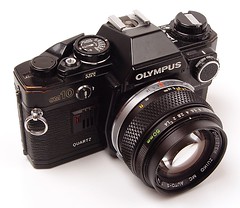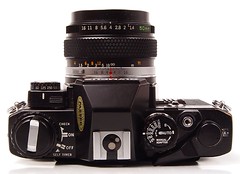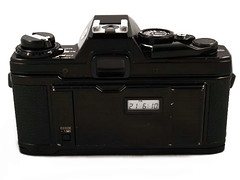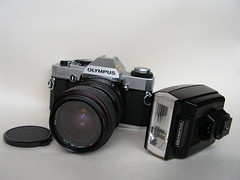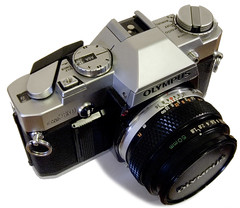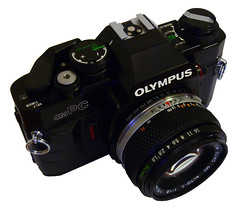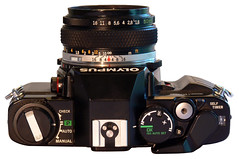The Olympus OM system was released by Olympus in 1972. The Olympus OM bodies were divided in a high range and a middle range. The top range were the one digit models with a hyphen: OM-1/2/3/4. The two digit models were the middle range. All these bodies could take Olympus OM lenses (which means all potentially have DOF preview functionality, as this was standard on most OM Lenses).
Following the introduction of autofocus into the market, Olympus released two motor-driven bodies: the OM707 and the OM101. Later yet, a re-branded Cosina model was released, known as the OM2000.
The OM10 and OM10 Quartz[]
The OM10 was the first consumer OM series body. Launched in 1979.
it accepted the full line of OM lenses and most of the OM accessories for a lower price. The lower price was reflected in the construction of this camera and the features available, however, it was still a very competent performer and it reflected the elegant lines established by the compact OM-1 and 2 designs. Early production runs of the OM10 have known malfunction issues with electronics, metering, and shutter magnets.source needed Olympus later changed the shutter to a 'Type II' design to correct the latter problem.source needed
In its standard configuration the OM10 offered aperture priority automatic exposure, simple and accurate enough for a consumer camera in most lighting situations. It also offered exposure compensation for more complicated lighting situations and for more advanced users. Selection dial upon the top allowed for selection of Aperture Priority, B and Manual adapter, The small plug-in manual adaptor was available as an accessory to enable manual control of shutter speed, if no Manual Adapter was plugged in and the camera switch set to Manual Adapter then the camera shutter speed was set to fixed 1/60 for flash work.
While not well known to consumers, the focusing screen for the OM10 is indeed interchangeable, though not as easily as the OM-1. It shares the same focusing screen as the OM-1, but the extra protruding tab needs to be cut off as the OM10 doesn't have a placeholder for it.
The OM10 can accept all the lenses of the OM system.
The finder screen is fixed, as well as the back. It can accept the winder but not the motor drive. It existed in chrome and in black finish.
In 1980 the OM10 Quartz was released with a fixed databack (equivalent of a Recordata Back 3) to print the time or date on your pictures. The OM10 Quartz was only released in black finish.
The OM10 was sold in large quantities before production ceased in 1987 and many working examples are still being used today. Largely overlooked in favor of its more professional 'single digit' siblings, you can easily pick up a working example for little money. Try to find one that includes the manual adaptor though, as this accessory alone can fetch good money at online auctions.
The OM20 / OM G[]
The OM20 was released in 1983. It was called OM G on some markets. It existed in chrome and in black finish.
It is basically an OM10 with manual shutter speed ring built-in, and a few other advances. These include a PC-sync flash connection, [LED] warnings in the viewfinder, built-in manual metering, and provision for attaching a steady grip. It didn't replace the OM10, but was available alongside it.
The OM30 / OM F[]
The OM30 was also released in 1983. It was called OM F on some markets. It existed in chrome and in black finish.
It was Olympus's first step towards an autofocus SLR camera. It was a true autofocus with one lens only, the 35–70mm AF zoom which had a motorized focusing ring, using three AAA batteries to operate it. With the other OM-mount lenses, correct focus was assisted with an indicator in the viewfinder.
The OM30 met quite limited success; Olympus' early autofocus system wasn't particularly accurate, fast or useful compared to its competitors. Minolta changed the camera market forever in 1985 with the Maxxum 7000, at which time Olympus made one more attempt at an AF OM body — the OM707 released in 1986. Again, this was a case of too little, too late and Olympus transferred focus in AF away from the OM system and into the IS line of cameras.
The OM30 is like the OM20 except for the following differences:
- focusing aid LED's in viewfinder
- F2/F4 switch for focus system
- In-Focus trigger cord socket (allowing pictures to be taken automatically as soon as the image is brought into focus)
- automatic focus with the Zuiko 35–70 AF zoom
- no PC flash socket
- no exposure compensation warning.
- The OM-30 also takes 5 SR44 batteries which mount in a compartment on the left hand side of the front of the camera. In place of the normal battery compartment is a switch to turn off the beeper.
The OM40 / OM PC[]
The OM40 was released in 1985. It was called OM-PC on some markets.
It has a modified, rubberised body, and is more rugged than the OM 10/20/30, yet cheaper than the OM-2SP. Like the OM-2SP it has a program mode, an aperture priority automatic mode and a manual mode. It has TTL flash automation, and a metering system called 'ESP' — a basic matrix system with two zones: center and edges. If the meter detects great differences in light between the center and the corners (e.g. a person wearing black against a white wall), it will disregard the corners in order to correctly expose the center. This mode works fine when the subject is placed centrally, but is not ideal for more artistic compositions.
The OM40 features the highest OM system integration of any of the double-digit bodies, though also strangely offers the lowest fps with the motor drive (3.5fps opposed to 5fps for all other compatible OM bodies)
Use of the program mode requires the user to manually stop down the aperture to the smallest they wish to use. The camera will hold the aperture open until the shutter is released and will choose a medium or high speed that correlates to a correct exposure, stopping down to the user-set minimum if necessary, but no further. In practice, the user would generally use f/16 in program mode, and shutter speeds good enough to freeze action (e.g. 1/250s) would be used.
As with the OM 10/20/30, the focusing screen is fixed, but it can accept all the motor drives/winders.
The OM40 only existed in black finish.
Some specifications:
- ISO 25–3200 (with automatic DX coding)
- Self-timer (12 seconds)
- Shutter speeds: B, 1–1000
- TTL flash automation
- Electro-Selective metering
- OTF metering
- 460 grams (body only)
Bibliography[]
- Francesch, Dominique and Jean-Paul. Histoire de l'appareil photographique Olympus de 1936 à 1983. Paris: Dessain et Tolra, 1985. ISBN 2-249-27679-X.
Links[]
General links[]
In English:
- Olympus OM-10 Review by VintageCameraReviews
- Olympus OM-20 Review by VintageCameraReviews
- Olympus OM-30 Review by VintageCameraReviews
- Olympus OM-40 Review by VintageCameraReviews
- Olympus OM10 at The Camera Site by Reijo Lauro
- OM10 in the Mediajoy's Classic Cameras (click the "Next" links for illustrated intructions of use)
- OM concept, history, instructions and manuals for OM cameras, lenses and accessories on Hans van Veluwen's Unofficial Olympus OM Sales Information File
- OM10 review at ciao.co.uk
- Olympus OM-1, OM-2SP, Zuiko lenses
- OM-20 Video Manual by Shawnee Union
In Chinese:
- OM20, OM30 and OM40 at www.ccc2000.net
- OM10, OM20, OM30, and OM40 in the Official Olympus History.
In French:
- On www.collection-appareils.fr by Sylvain Halgand :
Documentation[]
- Manuals for most OM models from Olympus USA's support site.
- Manual available on the Favorite Classics section of .kyphoto.com
- Manuals, including repair manual, available on this Dutch site
| Olympus Classic Cameras |
|---|
| Semi | Semi II | Six | Chrome Six | Flex | Standard | 35 | Ace | Pen | Pen F | FTL | OM-1/2/3/4 | OM-10/20/30/40 | OM-707 | OM-101 | XA |
